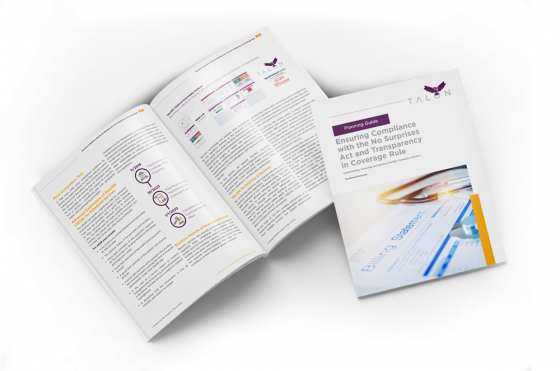Have you ever sat down to go through your personal budget and, as you’re scanning through your purchases, thought to yourself, I could have gotten that for less? You add up all those “could-haves”, and you’re left with a sum at the end of the month that you wish could have gone towards new shoes, or maybe a start of a vacation fund. At the time of these purchases, when you overpay for a good or a service, you have produced waste within your budget.
My company produces a report that analyzes a group’s healthcare spending in a similar fashion. We don’t adjust if they should have or should not have purchased, but simply, what could they have saved if they had an opportunity to shop for and receive care at the most cost-effective provider.
This report highlights the wild price variation in healthcare by identifying where a patient could have received care for the same exact procedure and aggregating the difference across the entire medical claims history for the group. We title this report Claims Hindsight Analysis, and as the saying goes, hindsight is 20/20, and thus, you’ll never repeat your claims history.
The total identified savings opportunity produced as a result of this report can be astounding. When providing this report to the company’s advisor, I make sure to inform them that this figure is with perfect shopping, 100% of the time, which is idealistic. It’s not possible. Not in today’s imperfect healthcare market. But even if the group were to grab 10% of this opportunity, there would be, in most cases, an ROI greater than 1.
This analysis emphasizes (sometimes brutally) the waste that can take place in healthcare. As reported by the recently published JAMA article “Waste in the US Health Care System”, the total annual costs of waste in the US totals somewhere between $760 billion to $935 billion.
As stated by the author of the article, “First, enhancing cost transparency might help. Addressing payment discrepancies between hospital outpatient facilities and office-based practices is crucial and has begun to happen. However, to meaningfully tackle costs and waste, it is necessary to address the high prices and administrative complexity that plague the US health care system, because, as the infamous bank robber Willie Sutton said when asked why he robbed banks, that is where the money is.”
I recently completed an analysis for a potential broker-partner who I want to work with in order to provide meaningful, valuable savings to their clients. It was my first interaction with them, although my team had provided a lunch and learn to their firm almost a year ago. They had reached out to me and indicated that they had a group that could benefit from our platform. To qualify the group, I offered to perform the Claims Hindsight analysis after learning a little more about the employer and their employees. The group is self-insured, with almost 400 enrollees in the New England and Mid-Atlantic regions.
The analysis indicated that almost 2/3rds of the group’s medical spend had been identified as a savings opportunity. That means that the employees are frequently and severely wasting, sometimes egregiously, and could save money by opting for care at high-quality, cost-effective facilities instead. High total waste means high total savings opportunity. That appears to me to be a very good thing.
The advisor did not see it that way. They first indicated that our analysis was inaccurate, or impossible, and that they would not feel comfortable putting these numbers in front of a CFO. So, I went back to my data analytics team and asked them to complete the analysis again. They growled, but obliged.
The results remained the same. 64% of the total spend was identified as total savings opportunity. Now, I want to note, I wouldn’t place this lump sum in front of a CFO without first identifying that this is with perfect shopping (unattainable), but with the right tools and incentives in place, a portion of this waste can be recaptured. It needs to be realistic, for the advisor, for the employer group, and for my company, as that’s the figure we’d be held to regarding our performance.
I indicated that the appropriate engagement and utilization levels can be applied to this figure to provide more realistic savings to be captured. Even after applying very, very low engagement percentages (10%), the ROI for the group could still be 7x, or well over $300,000 in savings as a result of shopping.
And yet still, the advisor informed me that these figures seem inflated. They felt very uncomfortable with these figures and indicated they felt unrealistic. And then proceeded to question the viability of our platform, who are our clients, etc. This may be my own bias and lack of intonation given email communication. Maybe I let the pride I feel for my team’s platform get in the way of addressing her questions and providing real examples of customers who have benefited.
So, what’s critically important about all of this?
I don’t need to inflate these numbers. This is the current state of costs regarding employer-sponsored health care. Prices between providers can vary by 20x. You compound the instances of employees receiving care at high-cost providers, where the price variation is hundreds, if not thousands, of dollars, it’s no wonder how astronomically inefficient and wasteful employers can be.
And of course, as an advisor, I wouldn’t want to share these figures with a CFO client. Especially one who runs a self-funded group. That’s money right out of their pocket. And then the difficult questions arise for the advisor, like “What have you done to control these costs? Why are these costs so high? How are we reining in the waste?”
To continue my story, the advisor informed me that they would like to hold off our discussion, the group is busy with many implementations, no time, no resources, same old excuses I hear time and time again. In the meantime, the employer will continue to overspend on healthcare.
Many of us probably read the reports about the waste in healthcare and think “no duh.” Waste stemming from being ignorant of marketplace price variation is one problem. But what about when we choose to ignore the potential savings opportunities out of fear of trying something new? This total cost of waste was for one group of only 400 employees. Can you imagine what that must look like when the employee count grows to 1,000? 2,000? But the market’s pricing variation can be the employer groups’ and the advisor’s opportunity for success. As stated by the author, “removing waste from US health care will require both awakening a sleepy status quo and shifting power to wrest it from the grip of greed.”
MMS Claims Hindsight Example







